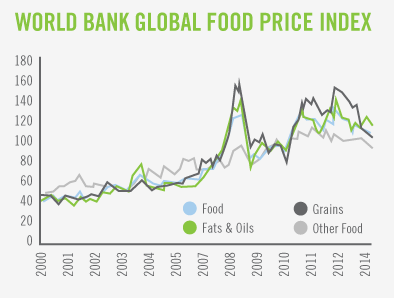FROM SCARCITY TO Security
“Soil is the foundation of civilization.” ~Lester Brown
SOIL AND FOOD SECURITY
Arable land with viable, healthy soil is a major factor in our ability to grow enough food to feed our growing population.
According to the World Health Organization, food security is built on three pillars :
- Food availability – sufficient quantities of food available on a consistent basis.
- Food access – sufficient resources to obtain appropriate foods for a nutritious diet.
- Food use – appropriate use based on knowledge of basic nutrition and care, as well as adequate water and sanitation.
The chart below shows how a country’s net cereal imports for consumption compares to how much households spend on food (World Bank’s Food Price Watch, August 2012). Whether a nation must import its food and what percent of family income must be spent on food are determined by several factors, including the country’s political and economic stability, its climate, and the quality of a nation’s soil.

When the price of food increases, people in countries at the upper right are extraordinarily vulnerable to hunger. In these countries, food is a major proportion of the family budget, and as the price goes up, they can purchase less.
In Burundi, for example, families spend approximately 60% of household income on food. Burundi is a net importer of cereal for human consumption, and prices increase there when they increase in commodity markets around the world.

In recent years, food prices have been extraordinarily volatile. Food availability and access in the vulnerable countries are threatened.
Food security may seem like an intractable problem. Are the Burundi’s of the world are destined to remain poor?
Fortunately, there is mounting evidence that this is not true. In the 2014 Annual Letter from the Bill and Melinda Gates, Bill Gates wrote:
“Poor countries are not doomed to stay poor. Some of the so-called developing nations have already developed. Many more are on their way. The nations that are still finding their way are not trying to do something unprecedented. They have good examples to learn from.
…Here is a quick list of former major recipients [of foreign aid] that have grown so much that they receive hardly any aid today: Botswana, Morocco, Brazil, Mexico, Chile, Costa Rica, Peru, Thailand, Mauritius, Singapore, and Malaysia.”
The Earth Restoration Foundation’s mission is to lead the advancement of global soil science and education. We work for a future where farmers in every country have the knowledge and resources to grow crops in a way that is energy efficient, sustainable, and well suited to their climate and soil… a future where food scarcity has become food security.